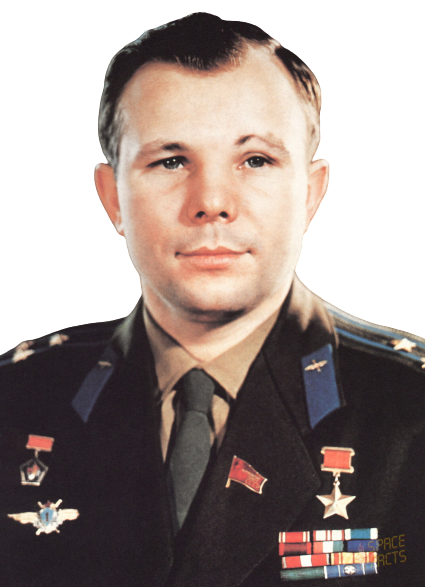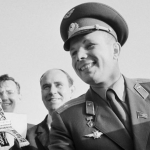
18.12.2022
March 9, 2014 is the 80th anniversary of the birth of Yuri Alexeyevich Gagarin, the first cosmonaut of the Earth.
The first man to fly into space, the USSR pilot-cosmonaut Yuri Alexeyevich Gagarin was born on March 9, 1934 in the village of Klushino, Gzhatsky (now Gagarinsky) district of Smolensk region.
His parents – Aleksey Ivanovich and Anna Timofeevna Gagarin were hereditary Smolensk peasants, collective farmers.
In 1941, Yuri Gagarin began studying at the high school in the village of Klushino, but his studies were interrupted by the war. He managed to resume his studies only in 1943. After the war, the Gagarin family moved to the town of Gzhatsk (now Gagarin), where Yuri continued his studies. After finishing the sixth grade, he entered a trade school in the town of Lyubertsy near Moscow and the Lyubertsy evening school for working youth. In 1951, he graduated from the seventh grade and the trade school with honors, specializing as a molder and foundry worker. In the same year he continued his studies at the Saratov Industrial Technical School.
As a student of the technical school, he enrolled in the flying club. In 1955 he graduated from the technical school and the flying club.
The same year he was called up in the Soviet Army and sent to Orenburg to study at the 1st Chkalov Military Aviation School named after Voroshilov, graduating in 1957 with first class honors. By his own choice he was sent to polar region to fighter aviation regiment of the Northern Fleet.
At the end of 1959 Gagarin wrote a report with a request to enroll him in the group of candidates for astronauts. Having passed many different tests and examinations, he was declared fit to fly in space by a special medical commission.
On March 3, 1960 by order of the Commander-in-Chief of the Air Force Yuri Gagarin was enrolled in the group of cosmonaut candidates.
On the 11th of October, 1960 by order of Commander-in-Chief of the Air Force he was enrolled in the group to prepare for the first manned space flight, and on the 8th of April, 1961 by a decision of the State Commission he was appointed a pilot of the spaceship “Vostok”.
On April 12, 1961 Yuri Gagarin made the first space flight in history of mankind in Vostok spaceship, circled the earth in one hour and 48 minutes and safely landed near Smelovka village of Ternovsky district of Saratov region.
At the end of April 1961, Gagarin embarked on his first foreign trip. “The Mission of Peace,” as the first cosmonaut’s trip across countries and continents is sometimes called, lasted two years. Kings and presidents, politicians and scientists, artists and musicians were honored to meet him.
On May 23, 1961 Yuri Gagarin was appointed commander of the cosmonaut team.
In the autumn of 1961 he joined the engineering faculty of Military Academy of Aircraft Engineering named after N.E. Zhukovsky and graduated in 1968 with honors with a degree in “Manned Air and Spacecraft and Engines for them” and qualified as a “pilot-cosmonaut-engineer.
From December 1963 to 1968 Yuri Gagarin was the deputy head of the Cosmonaut Training Center.
The cosmonaut returned to flight training in 1963, and in 1966 he began training for a flight on the new Soyuz spacecraft. In April 1967.
Gagarin was appointed as a stand-in for Vladimir Komarov, the commander of Soyuz-1 spacecraft, who made his first flight on the new spacecraft, which ended in the tragic death of the cosmonaut.
Yuri Gagarin conducted a great social and political work, being a deputy of the Supreme Soviet of the USSR of the 6th and 7th convocations, a member of the Komsomol Central Committee, president of the Soviet-Cuban Friendship Society.
Yuri Gagarin – Hero of the Soviet Union (1961), pilot-cosmonaut of the USSR (1961), Honorary radio operator (1962). Honored Master of Sports of the USSR (running, 1961).
Awarded with the “Gold Star” medal as Hero of the Soviet Union (1961), Order of Lenin (1961), medals of the USSR, received orders of many countries and awards of scientific and public organizations.
Gagarin is the author of “The Road to Space” (1962), “Seeing the Earth” (1976), co-author of “Psychology and Space” (1971).
On 27 March 1968 Colonel Yuri Gagarin was tragically killed in an air crash near the village of Novoselovo, Kirzhach district, Vladimir region, while performing a training flight on the MiG-15UTI. Flight instructor, regimental commander Vladimir Seregin died together with him.
The urn with Yuri Gagarin’s ashes is in the Kremlin wall in Moscow.
Gagarin married Valentina Goryacheva in 1957. The Gagarin family had two daughters, Elena (1959) and Galina (1961). At present Elena
D. in Art History, General Director of the State Historical and Cultural Museum-Reserve “The Moscow Kremlin”, Galina Gagarina – PhD in Economics, Head of the Department of National and Regional Economics of the Plekhanov Russian University of Economics.
In order to commemorate the cosmonaut, the city of Gzhatsk, Smolensk region, was renamed Gagarin. In 1968 the International Aviation Federation (FAI) established the Gagarin medal. Its first laureate was the USSR pilot-cosmonaut Georgiy Beregovoy.
The name of Gagarin was given to the Military Air Academy (after the reform as part of the Military Training and Research Center of Air Force “Military Air Academy named after professor N. E. Zhukovsky and Yu. The Komsomolsk-on-Amur aviation plant named after Gagarin, which is a branch of the Aviation Holding Company “Sukhoi”, Saratov State Technical University named after Yuri Gagarin, the airport of Orenburg (since 2011) are named after Gagarin.
His name was given to the memorial museum established in Gagarin, the museum of the Cosmonaut Training Center.
Streets and squares in many cities around the world are named after the first cosmonaut. In different cities monuments to Yuri Gagarin are installed, including those in Moscow, in Gagarin, in Star City. On the place where the first cosmonaut landed near the village of Smelovka an architectural complex “Gagarinskoye pole” was erected.
In July 2011, when it celebrated the 50th anniversary of the first cosmonaut’s visit to Britain, Gagarin’s monument was unveiled in front of the British Council in London. It was a gift to Great Britain from the Russian space agency. The location of the monument was temporary. In March 2013, the monument moved to the grounds of the Royal Observatory on the outskirts of the British capital, Greenwich, where it is installed on the terrace, named after the first cosmonaut. A crater on the moon and a small planet are named after the first cosmonaut.




